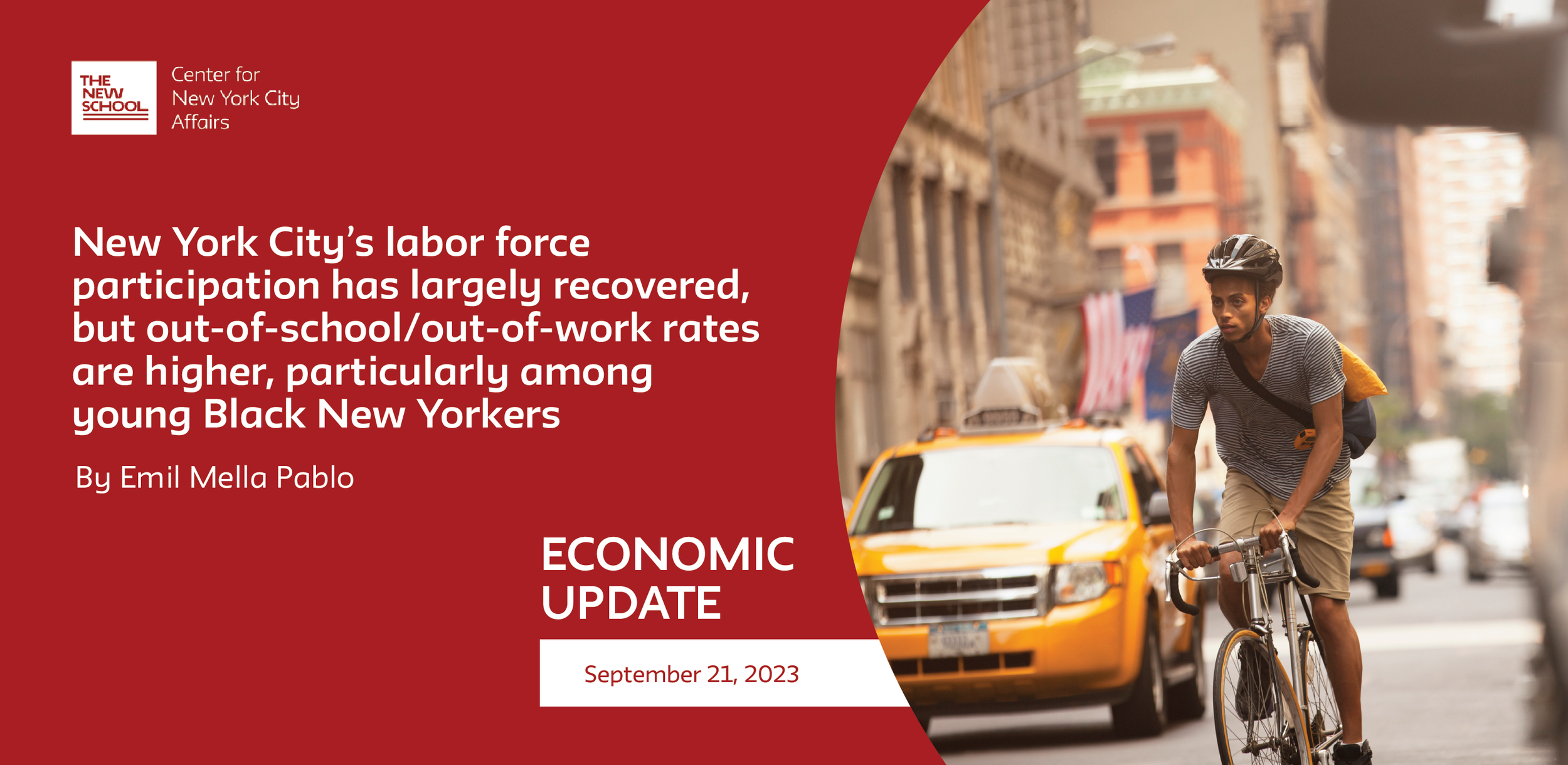New York City’s labor force participation has largely recovered, but out-of-school/out-of-work rates are higher, particularly among young Black New Yorkers
In the second quarter of 2023 (April-June), the seasonally adjusted unemployment rate in New York City rose to 5.9 percent, up from 5.3 percent in the first quarter of the year. The Bureau of Labor Statistics also reports no change in their monthly seasonally adjusted unemployment rate for New York City between July and August, remaining at 5.3 percent.
By way of contrast: While nationally the unemployment rate also rose this summer (to 3.8 percent in August from 3.4 percent in April), it remains at what is an historically low level, even as New York City lags pre-pandemic jobs performance.
The latest local employment statistics also report that monthly private job growth in NYC slowed to 5.9 thousand jobs in August, averaging just 3.1 thousand jobs per month in 2023 so far. That’s down substantially from an average of 20 thousand jobs per month in the first eight months of 2022. (CNYCA also estimates there has been a reduction of 10,000-20,000 local jobs in motion picture production and related industries due to the SAG/AFTRA-WGA strike.)
Overall, unadjusted Current Population Survey (CPS) labor force participation rates (LFPR) for female New Yorkers have surpassed pre-pandemic averages. Contrary to a common misperception that New York City women are still lagging pre-pandemic labor force participation, the average female LFPR in the last four quarters was 56.7 percent, comfortably exceeding their group pre-pandemic average of 53.8 percent.
Meanwhile, male workers’ LFPR has closely approximated their usual pre-pandemic levels. The LFPR for male New Yorkers averaged 67 percent over the last four quarters, compared to an average of 68.3 percent between Q2 2019 and Q1 2020. (That 68.3 percent level has only been exceeded once since, in Q1 2023.)
In our seasonally-adjusted estimates, the overall labor force participation rate rose by 0.3 points between the first two quarters of 2023, but the BIPOC category (which includes all workers except white non-Hispanic ones) LFPR lowered by the same amount. However, as the above chart highlights, New York City workers have surpassed pre-pandemic labor force participation levels regardless of their race/ethnicity category – although systemic inequalities in these levels by category continue. The BIPOC category only surpassed its pre-pandemic average in Q3 2022; Black non-Hispanic workers have seen faster seasonally adjusted improvements in their LFPR than Hispanic workers.
In our labor force analysis for the first quarter of the year, we called attention to an unusual divergence in unemployment rates by race and ethnicity in New York City, specifically estimating that the gap between unemployment rates for Black non-Hispanic and white non-Hispanic workers had widened over the course of 2022, and had reached its greatest disparity since at least the year 2000.
Preliminary signs from the Q2 2023 data do seem to point to some improvements in reducing the Black-white unemployment gap, or, at the very least, to a halt in its widening. In our seasonally adjusted estimates, the gap narrowed to 5.6 points in Q2 (Black unemployment rate of 9.4 percent, white unemployment rate of 3.8 percent) from 10 points in Q1 2023 (Black unemployment rate of 11.3 percent, white unemployment rate of 1.3 percent).
Out-of-school and out-of-work (OSOW)
Of great interest to policymakers is the proportion of 18-24-year-olds that are both “out of school, [and] out of work” (OSOW). Tracked in a four-quarter moving average (due to data volatility) the share of young people in this category swelled from 17 percent in Q1 2020 to 26 percent in Q4 2020. This increase was due to pandemic-related labor force displacements and disruptions to schooling; while it has been decreasing in the two-plus years since, it has yet to reach its pre-pandemic levels.
As the chart above shows, however, the overall picture on OSOW trends obscures the disparities experienced by different racial and ethnic groups. At its 2020 peak, work- and school-nonattendance among 18-24-year-olds grew the most among Black and Hispanic young people. (Before the onset of the pandemic, 18-24-year-old Black New Yorkers had the largest OSOW proportion of any group, at 19 percent.)
By Q2 2023, in the other racial/ethnic groupings (including Hispanic/Latinx) young people were within two or three percentage points of their Q1 2020 OSOW levels, However, over 26 percent of young Black New Yorkers were still reported as not being in work or school.
In Q2 2023, the not-seasonally adjusted unemployment rate for all workers ages 18-24 fell to 13.4 percent, down from 17 percent in Q1 2023. But there is a significant gender disparity embedded in these numbers, with the unemployment rate for young (18-24) male workers at 19.3 percent, over double that of young female workers (7.6 percent). That compares to a far smaller disparity for all workers 16 years old and up (7.4 percent unemployment for men, compared to 4.3 percent for women).
The unadjusted LFPR for 18-24-year-olds was 49.6 percent as of Q2 2023, down from 55.7 percent in the first quarter of 2020. Between the same time periods, their unadjusted employment-to-population (EPOP) rate fell nearly 10 points, from 52.7 percent to 43 percent. In short, more than half of NYC young adults in this age range are not working.
Taken alongside the increased and gender-disparate unemployment rates among young New Yorkers, as well as the noted gap in Black-white unemployment, these results continue to highlight how young New Yorkers, and, it seems, young Black male New Yorkers in particular, have suffered outsize employment and labor force participation impacts from the pandemic and the recent economic slowdown.
We’ve made some changes to our methodology for the reporting of quarterly seasonally adjusted labor market rates from the Current Population Survey; see the Technical notes section of our April 27 Economic Update for more information.

